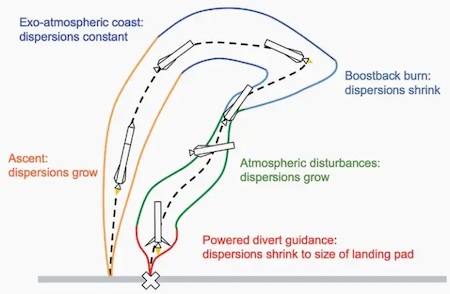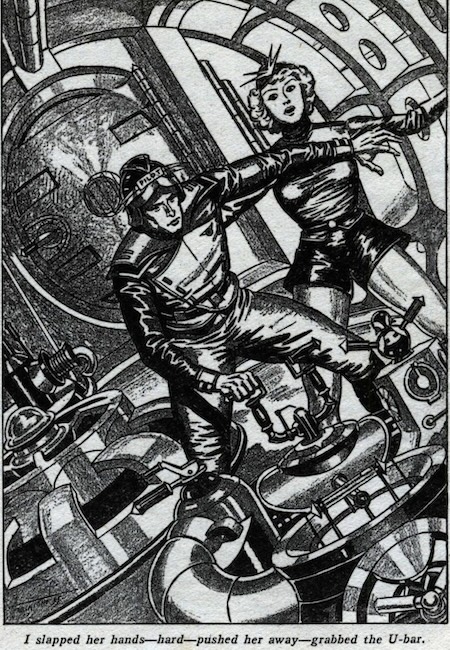Science Fiction
Dictionary
A B C D E F G H I J K L M N O P Q R S T U V W X Y Z
Can A Human Land A SpaceX Rocket On Its Tail?

I can't find the reference, but I seem to recall that Elon Musk has said that human beings can't do it. It's quite a trick, landing a 135.2 foot tall and 12 foot in diameter tube, with an empty mass of 56,423 pounds, on its tail on target.
The computing challenge is simple to describe and hard to execute: Plot the optimal path down to the target without running out of fuel. That’s complicated enough, but also consider the time constraint: The rocket’s computers need to solve this problem before they run out of fuel or crash into earth—in a “fraction of a second,” according to Blackmore. He and his colleagues developed one of the first algorithms to do this in three dimensions in that 2009 paper on Mars landings, receiving a patent on their ideas in 2013.
(A visualization of the rocket booster’s path back to earth)The solution involves solving a “convex optimization problem,” a common challenge in modern machine learning. In wildly reductive layman’s terms, it involves considering all the possible answers to the question of “what’s the best way to get from here to the landing pad without running out of fuel” as a geometric shape, and uses mathematical tools developed first by John von Neumann, the father of game theory, and refined by Indian mathematician Narendra Karmarkar in the 1980s, to quickly choose the best way down from that set.
(Via qz.)
It wasn't always so apparently easy and quick; here are some of SpaceX's less successful moments:
Science fiction authors have been utilizing their imagination in advance of engineering. In Redemption Cairn, by Stanley G. Weinbaum, published in Astounding Science Fiction in 1936, we read this description of trying to land a rocket on its tail:
"Those lousy reporters!” I blazed. "All of them seemed to think landing a rocket is like settling down in bed; you just cushion down on your underblast. Yeah; they don’t realize that you have to land blind, because three hundred feet from the ground the blast begins to splash against it.
I slapped her hands hard and grabbed the U-bar. I cut the underjets completely off, letting the ship fall free, then shot the full blast through the right laterals. It was damn close, I’m ready to swear, but we leveled, and I snapped on the underblast before we lost a hundred feet of altitude.('Redemption Cairn' by Stanley G. Weinbaum)"You watch the leveling poles at the edge of the field and try to judge your altitude from them, but you don’t see the ground ; what you see under you are the flames of Hell. And another thing they don’t realize; lowering a ship is like bringing down a dinner plate balanced on a fishing rod. If she starts to roll sideways — blooey! The underjets only hold you up when they’re pointing down, you know.”
Scroll down for more stories in the same category. (Story submitted 3/2/2024)
Follow this kind of news @Technovelgy.| Email | RSS | Blog It | Stumble | del.icio.us | Digg | Reddit |
Would
you like to contribute a story tip?
It's easy:
Get the URL of the story, and the related sf author, and add
it here.
Comment/Join discussion ( 0 )
Related News Stories - (" Space Tech ")
Will Space Stations Have Large Interior Spaces Again?
'They filed clumsily into the battleroom, like children in a swimming pool for the first time, clinging to the handholds along the side.' - Orson Scott Card, 1985.
Reflect Orbital Offers 'Sunlight on Demand' And Light Pollution
'I don't have to tell you about the seven two-mile-diameter orbital mirrors...'
Chrysalis Generation Ship to Alpha Centauri
'This was their world, their planet —
this swift-traveling, yet seemingly moveless vessel.' - Nat Schachner, 1934
The First Space Warship For Space Force
'Each of the electrical ships carried about twenty men...' - Garrett P. Serviss, 1898.
Technovelgy (that's tech-novel-gee!) is devoted to the creative science inventions and ideas of sf authors. Look for the Invention Category that interests you, the Glossary, the Invention Timeline, or see what's New.
Science Fiction
Timeline
1600-1899
1900-1939
1940's 1950's
1960's 1970's
1980's 1990's
2000's 2010's
Current News
Natural Gait With Prosthetic Connected To Nervous System
'The leg was to function, in a way, as a servo-mechanism operated by Larry’s brain...'
Woman Marries Computer, Vonnegut's Dream Comes True
'Men are made of protoplasm... Lasts forever.'
Spidery 'Walk Me' Toyota Autonomous Wheel Chair Like Star Wars
Walk along with the emperor.
Dancing Robots Taught Dance Moves
'A clockwork figure would be the thing for you...'
Proof Of Robothood - Not A Person
'Who are you people? - Show 'em.'
Indonesian Clans Battle
'The observation vehicle was of that peculiar variety used in conveying a large number of people across rough terrain.'
The 'Last Mile' In China Crowded With Delivery Robots
Yes, it's a delivery robot. On wheels.
Tornyol Microdrone Kills Mosquitoes
'The real border was defended by... a swarm of quasi-independent aerostats.'
PLATO Spacecraft, Hunter Of Habitable Planets, Now Ready
'I ... set my automatic astronomical instruments to searching for a habitable planet.'
Factory Humanoid Robots Built By Humanoid Robots
'...haven't you a section of the factory where only robot labor is employed?'
iPhone Air Fulfils Jobs' Promise From 2007 - A Giant Screen!
'... oblongs were all over the floor and surfaces.'
ChatGPT Now Participates in Group Chats
'...the city was their laboratory in human psychology.'
iPhone Pocket All Sold Out!
'A long, strong, slender net...'
Did The Yautja Have These First?
What a marvel of ingenuity the little device was!
Jetson ONE Air Races Begin, Can Air Polo Be Far Behind?
'If you're one of those rarities who haven't attended a rocket-polo "carnage", let me tell you it's a colorful affair.'
Will Space Stations Have Large Interior Spaces Again?
'They filed clumsily into the battleroom, like children in a swimming pool for the first time, clinging to the handholds along the side.'


